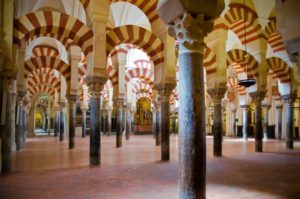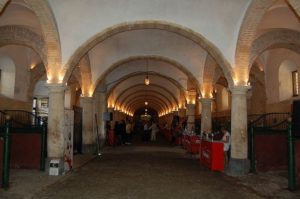 A building is enough reason to place Córdoba at the top of your itinerary: the fascinating multi-colored Mezquita. The Mezquita is one of the largest Islamic buildings in the world and is a symbol of the secular and refined culture that thrived here many years ago when the capital of Islamic Spain was Cordoba and the largest and most sophisticated city in Western Europe. But the Córdoba of today is way more than the Mezquita.
A building is enough reason to place Córdoba at the top of your itinerary: the fascinating multi-colored Mezquita. The Mezquita is one of the largest Islamic buildings in the world and is a symbol of the secular and refined culture that thrived here many years ago when the capital of Islamic Spain was Cordoba and the largest and most sophisticated city in Western Europe. But the Córdoba of today is way more than the Mezquita.
With plenty to see and do, charming accommodation, and excellent bars and restaurants, it deserves much more than the ephemeral visit many travelers make. Cordoba’s true charm unfolds when you explore the winding cobblestone streets of the medieval city of the colorful tourist area immediately around the Mezquita. Some colleagues of mine who run an Edmonton wedding DJ business told me about this hidden gem after they had visited a couple years back so I decided to do some more research on this place. Golden stone buildings and green courtyards appear every few minutes in another picturesque little hidden square. Here are the top must-see attractions in Cordoba, Spain.
Palacio de Viana
The Viana Palace is an impressive Renaissance palace with 12 beautiful courtyards full of plants. It is especially a pleasure in spring. The large building, which was inhabited by the noble Marqués de Viana, is full of antiques and arts. You can simply stroll through the charming courtyards and gardens with a self-guided brochure or take a tour of the rooms. It is located 800 meters northeast of the Plaza de las Tendillas.
Medina Azhara
8km west of Cordoba lies what remains of Medina Azahara, the magnificent palace city constructed in the 10th century by Caliph Abdul ar-Rahman. The complex encompasses a slope and the Caliph’s Palace on the highest level overlooking the open fields and gardens. Residential areas not yet excavated have been removed on both sides. A magnificent museum has been established below the site.
Centro Flamenco Fosforito
Perhaps Andalusia’s best flamenco museum, the Fosforito Center offers exhibitions, films, and information boards in English and Spanish that tell you the guitar history and all the great names in flamenco. The touchscreen videos show the important techniques of flamenco percussion, dance, guitar, and song. Free flamenco shows are also organized, often on Sundays at noon.
 Caballerizas Reales
Caballerizas Reales
These graceful stables were built in 1570 by order of King Felipe II, as a development center for the great Spanish thoroughbred warhorse. The center still breeds these beautiful horses and trains jockeys and horses in equestrian disciplines. You can follow the training during daily opening hours, Tuesday through Sunday (11 a.m.), or take part in the hour-long show, which remarkably combines the skills of horses and jockeys with dance and music of flamenco.